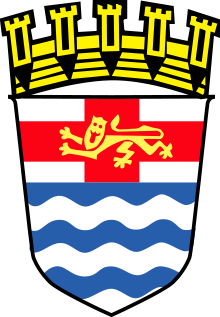- Coat of arms of London County Council
-
The London County Council was granted a coat of arms in 1914 and a heraldic badge in 1956. The coat of arms can still be seen on buildings constructed by the council before its abolition in 1965.
Contents
Background and initial designs
By 1894 the LCC had adopted a device consisting of "an armed female figure between the armorial bearings of the Cities of London and Westminster".[1] The question of an official coat of arms for the county council was first raised at a meeting of the council in 1897. Despite the opposition of two members on the grounds that it was "an insidious attempt to undermine the democratic character of the Council" and, jokingly, that they should not "degenerate to the level of the City Corporation", the General Purposes Committee were instructed to take steps to obtain a coat of arms.[2] Nothing seems to have come of this, and the unofficial device continued in use. In May 1906 the general purposes committee was asked to consider and report on whether the council should make an "application to the College of Arms or otherwise take steps to obtain a coat of arms, with a view to commemorating worthily its work in connection with public improvements, such as the construction of new streets and bridges, the restoration of ancient buildings and the like."[3] No further action appears to have been taken until February 1911, when the committee recommended that a coat of arms be obtained at a cost not exceeding £100. The recommendation was rejected by the council, with one member stating that the letters "L.C.C." would be good enough for the council. Another councillor sarcastically suggested the arms of the council should include, among other things, a wrecked ship, the shut gates of the work department and a tombstone to the memory of municipal enterprise with the motto "ad quod damnum".[4]
In 1914 the council chairman, Cyril Cobb offered to defray the cost of obtaining a grant of arms. Following discussions with the College of Arms, a design was submitted by the general purposes committee to the council on 24 February. The shield or arms featured a cross bearing an imperial crown between in the first and fourth quarters a depiction of the Tower of London, and in the second and third an ancient galley. A lion of England was to be shown the chief, or upper third of the shield. The suggested crest was a lion issuing from a mural crown and holding a banner of Saint George. The supporters were to be a Roman officer-of-arms and a Saxon warrior. The Latin motto loci dulcedo nos attinet or the pleasantness of the place holds us was suggested. This was adapted from the Annals of Tacitus, and was stated to be the earliest mention of London in history.
The towers were to represent strength and the galleys the shipping interests of the Metropolis. The cross, imperial crown and the lion in the crest were to show that London was the capital of the British Empire. The mural crown symbolised municipal government. The supporters illustrated the origins and early history of the city.[5]
Grant of arms
The final design for the arms, which was "simple in character and in every way suggestive of the corporate life of London", was agreed by the council on 26 May 1914.[6] The arms were blazoned as:
- Barry wavy of six azure and argent, on a Chief of the last the cross of St George charged with a lion of England, the shield ensigned with a Mural Crown gold"
The blue and silver waves represented the River Thames and the Port of London. The English lion on a St George's cross was to show that London was the royal centre of London. The gold mural crown was to indicate that the arms were those of a municipal body.[7]
As the arms included part of the royal arms (the English lion) a royal warrant was issued granting the arms on 29 July 1914. The arms were registered at the college of arms by letters patent dated 20 October 1914.
In 1953 a new representation of the arms, still agreeing with the 1914 blazon was adopted by the county council.
Heraldic badge
The arms granted in 1914 could only be used by the county council itself. The council decided that it required an emblem which it could allow clubs and societies associated with the County of London to use. Accordingly, they applied for the grant of an heraldic badge. The badge was granted by letters patent dated 12 March 1956, and was blazoned:
- An oval azure charged with two bars wavy argent, on a chief of the last a cross throughout gules, the whole encompassed by a rope or.
The badge repeated the main motifs from the arms: the blue and silver waves and cross of St George. The badge was encircled by a golden rope for the maritime associations of the county. The council permitted "organisations, societies, clubs and other bodies having a connection or association with the County of London" to display the badge subject to conditions imposed by the council.[8]
References
- ^ A. C. Fox-Davies, The Book of Public Arms, 1st edition, 1894
- ^ London County Council, The Times, 2 June 1897
- ^ Richard Crosley, London's Coats of Arms and the Story They Tell, 1928
- ^ London County Council - proposed coat of arms, The Times, 1 March 1911
- ^ London County Council - Mr Cyril Cobb's offer of a coat of arms - suggested design, The Times, 23 February 1914
- ^ London County Council, The council's coat-of-arms, The Times, 27 May 1914
- ^ T J Beningfield, London, 1900–1964. Armorial bearings and regalia of the London County Council, the corporation of London and the Metropolitan Boroughs, 1964
- ^ Leaflet published by the London County Council, September 1956
Wikimedia Foundation. 2010.



